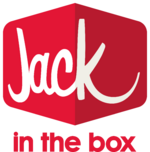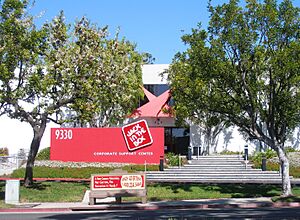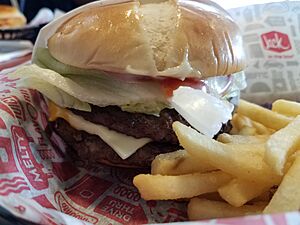Jack in the Box facts for kids
|
Logo used since October 4, 2022.
|
|
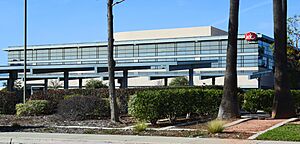
Jack in the Box headquarters in San Diego, California, in February 2025
|
|
| Public | |
| Traded as | NASDAQ: JACK S&P 600 Component |
| Industry | Restaurants |
| Genre | Fast food |
| Founded | 1951 |
| Founder | Robert O. Peterson |
| Headquarters | 9357 Spectrum Center Blvd, San Diego, California, U.S. |
|
Number of locations
|
2,217 (2021) |
|
Area served
|
21 states in the U.S. / 1 state in Mexico |
|
Key people
|
Lance Tucker (CEO) David Goebel (chairman) |
| Products | |
| Revenue | |
|
Operating income
|
|
| Total assets | |
| Total equity | |
|
Number of employees
|
c. 5,300 (2021) |
| Subsidiaries | Different Rules, LLC Del Taco |
Jack in the Box, Inc. is a popular American fast food restaurant chain. It was started on February 21, 1951, by Robert O. Peterson in San Diego, California. The company's main office is still in San Diego.
Today, Jack in the Box has over 2,200 restaurants. Most of these are on the West Coast of the United States. You can also find them in big cities outside the West Coast. There are even two locations in Guam. The company used to own Qdoba Mexican Grill. However, that chain was sold in December 2017.
Jack in the Box offers many different foods. These include chicken tenders, french fries, and various hamburgers and cheeseburgers. They also have internationally inspired items like tacos and egg rolls.
Contents
How Jack in the Box Started
Robert O. Peterson was already a successful restaurant owner. In 1941, he opened Topsy's Drive-In in San Diego. He opened several more Topsy's locations. By the late 1940s, his restaurants had a fun, circus-like look. They featured drawings of a happy clown.
In 1947, Peterson learned about a new idea for ordering food. This was the intercom ordering system. George Manos used it at his Chatterbox restaurant in Alaska. This was one of the first places to use an intercom for drive-up windows.
The First Jack in the Box
In 1951, Peterson changed his Topsy's location on El Cajon Boulevard. He turned it into the first Jack in the Box. This new restaurant focused on drive-through service. Drive-throughs were not new, but Jack in the Box made a big change. They were the first major chain to use a two-way intercom system. They were also the first to focus mainly on drive-through service.
The intercom made service much faster. While one customer got their food, others could place their orders. A huge clown figure was on the roof. A smaller clown head was on the intercom. A sign there said, "Pull forward, Jack will speak to you." The restaurant was designed to be a "modern food machine." It was very popular because of its quick service. Soon, all of Peterson's other restaurants became Jack in the Box locations.
Growing the Business
In 1960, Peterson created Foodmaker, Inc. This company managed all the Jack in the Box restaurants. At this time, there were over 180 locations. Most were in California and the Southwest. All these restaurants were owned by the company. They had strict rules for locations, food, and staff training.
In 1968, Peterson sold Foodmaker to the Ralston Purina Company. In the 1970s, Jack in the Box grew a lot. They started to offer franchises, meaning other people could open their own Jack in the Box restaurants. The chain began to look more like bigger competitors, such as McDonald's.
Changing the Brand
Around 1980, Foodmaker changed Jack in the Box's marketing. They showed the chain's clown symbol, the jack-in-the-box, being blown up in TV ads. The new slogan was, "The food is better at the Box." Jack in the Box decided not to compete for families with young children anymore. Instead, they aimed for older customers. They offered a higher-quality menu. Their TV ads were funny and featured Dan Gilvezan. He tried to compare their new menu items to other fast-food chains. The slogan became "There's No Comparison."
Jack in the Box restaurants were updated with new colors and plants. The logo also changed. The clown's head was removed from the logo by 1981 or 1982. TV ads from 1985 onward used simple, unique music. The menu became much more varied. It included salads, chicken sandwiches, and Curly Fries. They added at least two new items each year. This was at a time when most fast-food places only offered hamburgers. Sales grew throughout the 1980s.
In late 1985, Ralston Purina tried to change the restaurant's image again. They renamed it "Monterey Jack's." But this name change was not popular. The Jack in the Box name was brought back in early 1986.
After 18 years, Ralston Purina sold Foodmaker in 1985. By 1987, sales reached $655 million. The chain had 897 restaurants. Foodmaker then became a public company. This meant its shares could be bought and sold on the stock market.
In December 2021, Jack in the Box announced they would buy Del Taco. Del Taco had about 600 locations. The deal was completed in March 2022.
JBX Grill Restaurants
In 2004, Jack in the Box Inc. tried a new type of restaurant called JBX Grill. These were "fast casual" restaurants. They offered higher-quality, cafe-style food. They avoided the cheaper fast-food items. The restaurants had a cheerful look and good customer service. Two Jack in the Box locations in San Diego were changed into JBX Grill restaurants to test the idea. Other locations were in Bakersfield, California, and Boise and Nampa, Idaho. However, the idea did not work out. The last JBX Grill stores were changed back to Jack in the Box in 2006.
What Jack in the Box Sells
Jack in the Box is known for its hamburgers. But its most popular item is the taco. They have sold tacos since the first restaurant opened in the 1950s. As of 2017, the company sold 554 million tacos each year. These tacos are made in factories in Texas and Kansas. The meat and hard taco shell are frozen for transport. At the restaurant, they are deep-fried. Then, they are prepared with lettuce, cheese, and mild taco sauce.
Besides tacos, Jack in the Box offers other foods inspired by different cultures. These include egg rolls, breakfast burritos, and jalapeño poppers. New items are added every few months. These have included the Philly cheesesteak and deli-style pannidos. They also have seasonal items like pumpkin pie shakes and eggnog shakes during holidays.
In some places, the menu includes local favorites. For example, in Hawaii, they offer the Paniolo breakfast. This has Portuguese sausage, eggs, and rice. In the Southern United States, they sell biscuits and sweet tea. In Imperial County, California, some locations sell date shakes.
The Bonus Jack burger was first released in 1970. It has been brought back to the menu at different times. It still has "Jack's secret sauce." In 2012, Jack in the Box introduced a bacon milkshake.
The Sourdough Jack burger has been around since 1997. It uses two slices of sourdough bread with a hamburger patty. It was first introduced in 1991.
Munchie Meals and More
In September 2013, Jack's Munchie Meal was introduced. The first four Munchie Meals were the Spicy Nacho Chicken Sandwich, Sriracha Curly Fry Burger, Stacked Grilled Cheeseburger, and Chick-n-Tater Melt. Each meal also came with two tacos, halfsie fries (curly fries and french fries), and a drink. In 2023, these items were replaced. Now, you can build your own Munchie Meal. Choices include an Ultimate Cheeseburger, Jack's Spicy Chicken Sandwich, Cluck Sandwich, and a Double Jack.
In October 2016, "Brunchfast" items were added. These included a Bacon and Egg Chicken Sandwich, Brunch Burger, and Homestyle Potatoes. In January 2018, "Food Truck Series" sandwiches were introduced. These included the Asian Fried Chicken and Prime Rib Cheesesteak.
In January 2023, Jack in the Box started selling Red Bull Infusions drinks. In February 2023, they partnered with Mint Mobile and Ryan Reynolds. They created a "Mint Mobile Shake," which was a minty Oreo Shake.
The chain also sometimes serves a fish sandwich. It was brought back for a short time during the Lenten season in 2023.
Advertising and Mascots
The restaurant became popular again in 1994. This was after a very successful marketing campaign. It featured a made-up character named Jack. He was the chairman of Jack in the Box. Jack has a ping pong ball-like head, a yellow clown cap, blue eyes, a black nose, and a red smile. He wears a business suit.
Jack was brought back to show the company was changing. This was after a challenging time in 1993 related to food safety. This event had threatened the chain's existence. In the first ad in 1994, Jack confidently walks into the boardroom. He says he's back "through the miracle of plastic surgery." Then, he blows up the boardroom. The ad ends with a bag of food dropping onto a table. The bag says "Jack's Back." Later ads show the name of the food item being promoted.
The "Jack's Back" commercials are usually funny. They often show Jack making business decisions about food. Or he is out getting ideas for new menu items. Many ads also gave away free car antenna balls with meals. This helped more people recognize the brand. Different antenna balls were available for holidays or sports teams. These antenna balls are no longer given out.
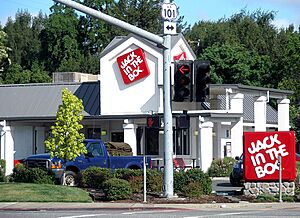
During the XFL football league's popularity, Jack owned a fake football team. They were called the Carnivores. They played against teams like the Tofu Eaters.
In 1997, a successful ad campaign featured a fake music group. They were called the Spicy Crispy Girls. This was a funny version of the Spice Girls. The ads promoted the new Spicy Crispy Chicken Sandwich. The Spicy Crispy Girls concept was later used for the 'Meaty Cheesy Boys.' This group promoted the Ultimate Cheeseburger in 1999-2001.
The Meaty Cheesy Boys were a mock boy band. They were created in 1999 to promote the Ultimate Cheeseburger. They even "performed" their song "Ultimate Cheeseburger" at the 1999 Billboard Music Awards.
In April 2006, Jack in the Box started an ad campaign called "Bread is Back." This made fun of the low-carbohydrate diets that were popular then.
In 2007, Jack in the Box began ads for their new 100% sirloin beef hamburgers. They suggested their burgers were better than those from other chains.
Jack in the Box Logos
The Jack in the Box logo has changed over time. In October 1977, the logo had a small clown hat with three dots. The clown head was removed in 1980. Before late 2008, most Jack in the Box locations had an older logo. However, the chain has been updating them with the newer logo. Some locations still use the old logo for their "Open/Closed" signs.
Where to Find Jack in the Box
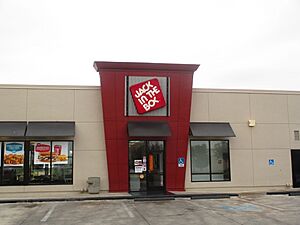
In 2005, Jack in the Box announced plans to open restaurants across the country by 2010. They started showing ads in states far from their current locations. They aimed to expand into Colorado, Delaware, Florida, and Texas. In 2007, the first new Colorado store opened in Golden. This marked Jack in the Box's return to the state after 11 years.
In June 2009, several locations opened in Albuquerque, New Mexico. Jack in the Box had not been in that market for about 20 years. In September 2010, 40 Jack in the Box restaurants that were not doing well closed. Most of these were in Texas and the Southeast.
In March 2011, Jack in the Box launched the Munchie Mobile in San Diego. This was a food truck that served Jack's burgers and fries. They launched a second food truck in the Southeast in June 2012. Another truck started in Northern Texas in April 2013.
In January 2012, Jack in the Box opened its first of three locations in the Indianapolis area. A few months later, the first Ohio location opened in September 2012.
In May 2023, Jack in the Box showed interest in returning to the Mexican market. They had briefly operated there in the early 1990s. In February 2024, Jack in the Box opened a new location in Chihuahua City, Mexico.
In July 2024, Jack in the Box announced plans to open several stores in the Chicago area in 2025. The chain had expanded in Chicago before, from the late 1960s until the 1980s. So far, eight locations are planned to open.
Jack in the Box also plans to open up to 20 locations in the Orlando, Florida, area. The first location will be on John Young Parkway. Other planned locations include Lake Nona and Kissimmee.
Sponsorships
In November 2017, Jack in the Box became a sponsor for the Dallas Fuel. This is a team in the Overwatch League. They also sponsor Team Envy, a professional video game-playing team.
Jack in the Box is also a current sponsor for the San Francisco 49ers football team. They sponsor the Los Angeles Dodgers baseball team and the Arizona Diamondbacks baseball team.
See also
 In Spanish: Jack in the Box para niños
In Spanish: Jack in the Box para niños
- List of hamburger restaurants


